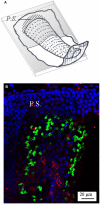Glutamic acid decarboxylase 67 expression by a distinct population of mouse vestibular supporting cells
- PMID: 25565962
- PMCID: PMC4269132
- DOI: 10.3389/fncel.2014.00428
Glutamic acid decarboxylase 67 expression by a distinct population of mouse vestibular supporting cells
Erratum in
-
Corrigendum: Glutamic acid decarboxylase 67 expression by a distinct population of mouse vestibular supporting cells.Front Cell Neurosci. 2015 Apr 1;9:101. doi: 10.3389/fncel.2015.00101. eCollection 2015. Front Cell Neurosci. 2015. PMID: 25883549 Free PMC article.
Abstract
The function of the enzyme glutamate decarboxylase (GAD) is to convert glutamate in γ-aminobutyric acid (GABA). Glutamate decarboxylase exists as two major isoforms, termed GAD65 and GAD67, that are usually expressed in GABA-containing neurons in the central nervous system. GAD65 has been proposed to be associated with GABA exocytosis whereas GAD67 with GABA metabolism. In the present immunofluorescence study, we have investigated the presence of the two GAD isoforms in the semicircular canal cristae of wild type and GAD67-GFP knock-in mice. While no evidence for GAD65 expression was found, GAD67 was detected in a distinct population of peripherally-located supporting cells, but not in hair cells or in centrally-located supporting cells. GABA, on the other hand, was found in all supporting cells. The present result indicate that only a discrete population of supporting cells use GAD67 to synthesize GABA. This is the first report of a marker that allows to distinguish two populations of supporting cells in the vestibular epithelium. On the other hand, the lack of GABA and GAD enzymes in hair cells excludes its involvement in afferent transmission.
Keywords: GAD67-GFP; crista ampullaris; hair cells; supporting cells; vestibular.
Figures









References
LinkOut - more resources
Full Text Sources
Other Literature Sources
Molecular Biology Databases

